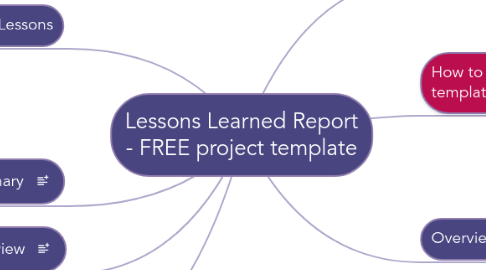
1. Significant Lessons
1.1. Event
1.1.1. [...]
1.2. Effect
1.2.1. [State the positive or negative effect of the event]
1.3. Causes/Trigger
1.3.1. [...]
1.4. Early Warnings?
1.4.1. [State whether there where any early-warning indicators]
1.5. Identified as a Risk?
1.5.1. [State whether the triggered event was previously identified as a risk (threat or opportunity)]
1.6. Recommendations
1.6.1. [...]
2. Executive Summary
2.1. [Specify the scope of the report e.g. Stage or Project]
3. Overall Review
3.1. [Review what went well, what went badly and any recommendations for corporate or programme management consideration. In particular: Project management method; Any specialist methods used; Project strategies; Project controls and Abnormal events causing deviations]
4. Review of Useful Measures
4.1. [Review useful measures such as: How much effort was required to create the products; How effective was the Quality Management Strategy in designing, developing and delivering fit-for-purpose products and Statistics on issues and risks]
5. Document information
5.1. Project Name
5.1.1. [name]
5.2. Date
5.2.1. [date]
5.3. Release
5.3.1. Draft/Final
5.4. Author
5.4.1. [author]
5.5. Owner
5.5.1. [owner]
5.6. Client
5.6.1. [client]
5.7. Document Number
5.7.1. [number]
5.8. Revision, Approvals & Distribution
5.8.1. Revision History
5.8.1.1. Revision # [....]
5.8.1.1.1. Revision Date
5.8.1.1.2. Previous Revision Date
5.8.1.1.3. Summary of Changes
5.8.1.1.4. Changes Marked
5.8.1.2. Revision # [....]
5.8.1.2.1. Revision Date
5.8.1.2.2. Previous Revision Date
5.8.1.2.3. Summary of Changes
5.8.1.2.4. Changes Marked
5.8.1.3. Revision # [....]
5.8.1.3.1. Revision Date
5.8.1.3.2. Previous Revision Date
5.8.1.3.3. Summary of Changes
5.8.1.3.4. Changes Marked
5.8.1.4. Date of next revision:
5.8.1.4.1. [....]
5.8.2. Approvals
5.8.2.1. Approval # [....]
5.8.2.1.1. Name
5.8.2.1.2. Signature
5.8.2.1.3. Title
5.8.2.1.4. Date of Issue
5.8.2.1.5. Version
5.8.2.2. Approval # [....]
5.8.2.2.1. Name
5.8.2.2.2. Signature
5.8.2.2.3. Title
5.8.2.2.4. Date of Issue
5.8.2.2.5. Version
5.8.2.3. Approval # [....]
5.8.2.3.1. Name
5.8.2.3.2. Signature
5.8.2.3.3. Title
5.8.2.3.4. Date of Issue
5.8.2.3.5. Version
5.8.3. Distribution
5.8.3.1. Distribution # [....]
5.8.3.1.1. Name
5.8.3.1.2. Title
5.8.3.1.3. Date of issue
5.8.3.1.4. Version
5.8.3.2. Distribution # [....]
5.8.3.2.1. Name
5.8.3.2.2. Title
5.8.3.2.3. Date of issue
5.8.3.2.4. Version
6. How to use this template
6.1. How to share this template with your team
6.1.1. Send an email
6.1.1.1. 1. Click Share this map
6.1.1.2. 2. Select Invite People
6.1.1.3. 3. Write a message
6.1.1.4. 4. Click Invite
6.1.2. Send a link
6.1.2.1. 1. Click Share this map
6.1.2.2. 2. Tick Link to share
6.1.2.3. 3. Copy the link to share it
6.1.3. Export
6.1.3.1. 1. Click down arrow, bottom right
6.1.3.2. 2. Select the export option you want
6.2. How to complete this template
6.2.1. Complete the sections in square brackets
6.2.1.1. [....]
6.2.2. Read these sections for help on this template
6.2.2.1. Purpose
6.2.2.2. Advice
6.2.3. Navigate using the links in Contents
6.2.3.1. Contents
6.3. Attribution
6.3.1. Copyright © AXELOS Limited 2009. All rights reserved. Material is reproduced with the permission of AXELOS
6.4. Get this template here
7. Overview
7.1. Purpose
7.1.1. The Lessons Report is used to pass on any lessons that can be usefully applied to other projects. The purpose of the report is to provoke action so that the positive lessons become embedded in the organization’s way of working, and that the organization is able to avoid any negative lessons on future projects.
7.1.2. A Lessons Report can be created at any time in a project and should not necessarily wait to the end. Typically it should be included as part of the End Stage Report and End Project Report. It may be appropriate (and necessary) for there to be several Lessons Reports specific to the particular organization (e.g. user, supplier, corporate or programme).
7.1.3. The data in the report should be used by the corporate group that is responsible for the quality management system, in order to refine, change and improve the standards. Statistics on how much effort was needed for products can help improve future estimating.
7.2. Contents
7.2.1. The Lessons Report should cover the following topics.
7.2.2. Executive Summary
7.2.3. Overall Review
7.2.4. Review of Useful Measures
7.2.5. Significant Lessons
7.3. Advice
7.3.1. The Lessons Report is derived from the following documents: Project Initiation Documentation (for the baseline position); Lessons Log (for identification of lessons); Quality Register, Issue Register and Risk Register (for statistical analysis); Quality records (for statistical analysis) and Communication Management Strategy (for the distribution list).
7.3.2. The Lessons Report can take a number of formats, including: Oral report to the Project Board (could be in person or over the phone); Presentation at a progress meeting (physical meeting or conference call); Document or email to the Project Board; Entry in a project management tool.
7.3.3. The following quality criteria should be observed:
7.3.3.1. Every management control has been examined
7.3.3.2. Statistics of estimates versus actuals are provided
7.3.3.3. Statistics of the success of quality controls used are included
7.3.3.4. Any appointed Project Assurance roles agree with the report
7.3.3.5. Unexpected risks are reviewed to determine whether they could have been anticipated
7.3.3.6. Recommended actions are provided for each lesson (note that lessons are not ‘learned’ until action is taken).
